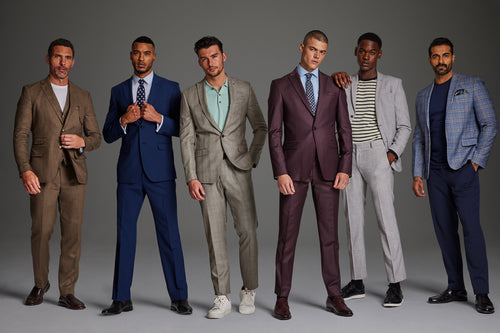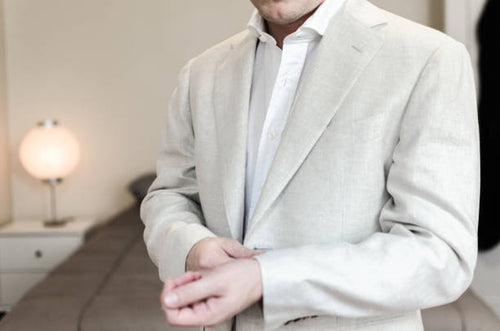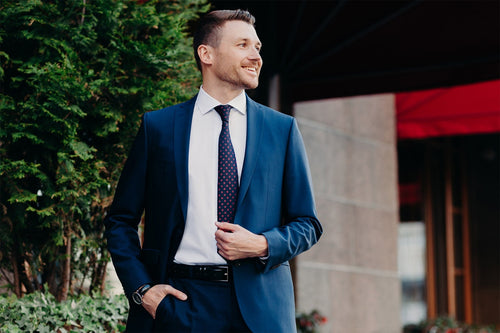
What is a Formal Tuxedo? A Guide to Formal Wear for Men
What is a Formal Tuxedo?
A tuxedo is a black or white jacket worn mainly by men for formal social events.
A tuxedo is also a classic and timeless formal attire worn mainly to black-tie events, such as galas, award ceremonies, and extravagant weddings.
A tuxedo is the essence of formal elegance and is typically reserved for occasions where a sophisticated and polished appearance is paramount. Its significance lies in its ability to convey a sense of refinement and grace, making it the best choice for events that demand the utmost in sartorial splendor.
History of the Tuxedo
The tuxedo begins with its origins in the late 19th century. The tuxedo was initially designed as a less formal alternative for men attending semi-formal events. Named after Tuxedo Park, a fashionable enclave in New York, this garment quickly gained popularity for its versatility and modern aesthetic.
Over time, the tuxedo evolved from a symbol of rebellion against rigid formal wear norms to an emblem of sophistication and class. Its transformation into the pinnacle of formal attire occurred as societal norms shifted, and the tuxedo became synonymous with black-tie affairs. The evolution of the tuxedo reflects changes in fashion, cultural attitudes, and the desire for a more comfortable yet refined alternative to traditional evening wear.
The Components of a Formal Tuxedo
A formal tuxedo comprises various elements contributing to its elegance and formality. These components define the attire and establish a visual language that communicates sophistication and attention to detail.
Tuxedo Accessories
The Dinner Jacket
The centerpiece of any tuxedo ensemble, the dinner jacket is characterized by its black or midnight blue color, typically crafted from high-quality wool. The single-breasted design with a sole front button exudes classic charm. The lapels in notch, peak, or shawl variations feature a satin facing, elevating the jacket's formality.
Trousers
Matching the jacket in color and material, tuxedo trousers are essential to achieving a cohesive look. Adorned with a satin stripe down each leg, these trousers emphasize formality and create a seamless transition from jacket to trousers.
Suspenders or Braces
To maintain the sleek silhouette of a tuxedo, suspenders or braces replace belts. This subtle accessory ensures trousers stay in place without creating bulkiness, aligning with the tuxedo's polished and streamlined appearance objective.
Dress Shirt
A crisp, classic, white button-down dress shirt complements the tuxedo. Often pleated down the front with cufflink-ready sleeves, this shirt adds a touch of sophistication to the ensemble.
The Cummerbund
A quintessential part of traditional tuxedo attire, the cummerbund serves both functional and aesthetic purposes. The cummerbund completes the formal look by keeping the dress shirt in place and offering a flattering torso contour.
Bow Tie
The bow tie is a symbol of sophistication, the preferred neckwear for tuxedo events. Traditionally hand-tied and made of satin, the black bow tie adds a final touch of refinement to the ensemble.
Other Accessories
Subtle additions like socks, a pocket square, and cufflinks provide the finishing touches. In adherence to the formal tone, these accessories should exude understated elegance, avoiding bold patterns and vibrant colors.
When to Wear a Tuxedo
Public Events
For grand events like opera premieres, ballets, and symphonies, a tuxedo is not just an option; it's a statement. Black-tie attire is the norm, embracing the classic ensemble of a black or midnight blue jacket paired with formal accessories. The timeless appeal of a tuxedo aligns seamlessly with the prestige of such artistic gatherings.
Debutante Ball
A tuxedo adds a touch of refinement if you are attending a formal dinner or a grand dance like a debutante ball. While traditional suits are acceptable, nothing beats the elegance of a well-tailored tuxedo with a bow tie. Private balls, often organized by large institutions, call for the complete tuxedo package, including trousers, shirts, and black patent leather shoes.
Quinceañera
The Quinceañera, celebrating a girl's 15th birthday, demands formality. While not strictly a black-tie event, a tuxedo can be suitable, especially for adults and mature boys. The occasion's significance aligns with the sophistication of a tuxedo, making it a tasteful option for the celebration.
Weddings
Weddings often call for black-tie attire, especially those held after six o'clock. Grooms and groomsmen don the classic tuxedo, symbolizing a commitment to elegance and formality. A well-fitted tuxedo, accompanied by a bow tie and other formal accessories, enhances the overall aesthetic of the wedding party.
Cruises
While cruises may seem like a dream excursion, formal parties aboard ships occasionally require a tuxedo. Evening events with a formal dress code demand the sophistication of a tuxedo. Some cruise lines offer formal wear rentals, ensuring you're appropriately attired for the glamorous occasions at sea.
Fraternal Organization Events
Special events hosted by fraternal organizations often call for a double-breasted suit with a shawl collar. Etiquette experts emphasize the importance of proper attire, especially for prestigious university seminars and parties. The dress code may vary, so checking specific instructions from the institution is advisable.
Business Dinners
While not strictly black-tie, business dinners often maintain a formal atmosphere. Opting for a dark suit with a white shirt and a conservative tie is standard, but if the opportunity presents itself, choosing a tuxedo can set you apart, making a memorable impression.
Diplomatic Events
Diplomatic functions, particularly those with international dignitaries, often adhere to black-tie or white-tie dress codes. Tuxedos are commonly accepted in such gatherings, exuding an aura of refinement suitable for diplomatic settings. Understanding the specific dress code, whether black tie or white tie, ensures you navigate these formal occasions with grace.
Tuxedo vs. Suit
While both exude an air of sophistication, the tuxedo, and the suit stand apart in subtle yet significant ways, from the presence of satin to the choice of accessories and the occasions they grace.
The Satin Touch: Lapels, Buttons, Pockets, and Legs
The defining distinction between a tuxedo and a suit lies in incorporating satin. Tuxedos boast satin detailing on the lapels, buttons, pockets, and pant legs, contributing to a sleek and formal aesthetic. In contrast, suits typically forgo the satin embellishments, opting for a more understated and versatile appearance.
Accessories
Accessorizing plays a pivotal role in distinguishing between a tuxedo and a suit. A tuxedo welcomes accessories such as a cummerbund, bow tie, suspenders, and a pleated button-down shirt. These elements contribute to the elevated formality of the tuxedo ensemble. On the other hand, a suit pairs seamlessly with a belt, necktie, and an unpleated button-down shirt, reflecting a more business or business-casual demeanor.
Events
Understanding the appropriate occasions for donning a tuxedo versus a suit is crucial. Tuxedos are the show's stars at black-tie events like charity balls and high-end weddings. Their formal allure aligns perfectly with these upscale occasions, making them the attire of choice for those seeking a polished and refined look. On the other hand, suits are versatile companions suitable for less formal events, ranging from business meetings to birthday parties and casual dates.
Making the Right Choice: Tuxedo or Suit?
The event's formality serves as a guiding factor when deciding whether to opt for a tuxedo or a suit. If the dress code calls for black tie, the regal presence of a tuxedo is unmatched. The satin detailing and formal accessories create a look that transcends everyday elegance. Conversely, a suit steps into the spotlight for events with a more relaxed dress code, offering a tailored and polished appearance without the heightened formality associated with tuxedos.
Wrap up
We hope this article will help you know about the complete details of formal tuxedos. A formal tuxedo is not merely an ensemble but a symbol of refined taste, making a powerful statement that will help you leave a lasting impression on the event.
Faqs
Can you wear a tuxedo casually?
The tuxedo is traditionally reserved for formal events, but modern fashion allows for some casual interpretations of the tuxedo. Opt for more relaxed fabrics and pair them with casual accessories for a semi-formal look.
Is a white or black tux more formal?
Generally, black tuxedos are considered more formal and traditional for evening events. White tuxedos, often associated with warm-weather occasions, are considered less formal but can still make a sophisticated statement.
Does formal attire mean a tuxedo?
Formal attire doesn't strictly mean a tuxedo. It encompasses a range of dress codes, with a tuxedo reserved for black-tie events. Formal attire can also include dark suits and other elegant ensembles, depending on the specific dress code of the event.
Related Products































































Leave a comment
This site is protected by hCaptcha and the hCaptcha Privacy Policy and Terms of Service apply.